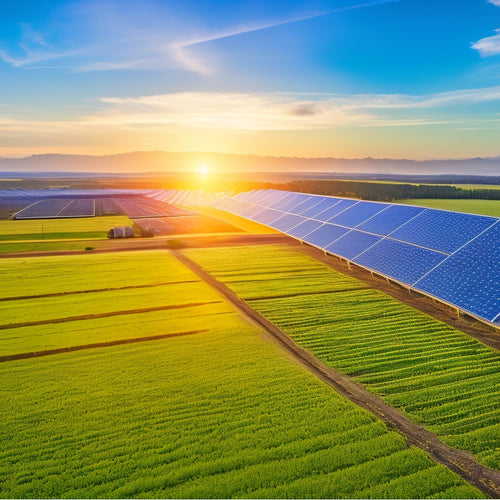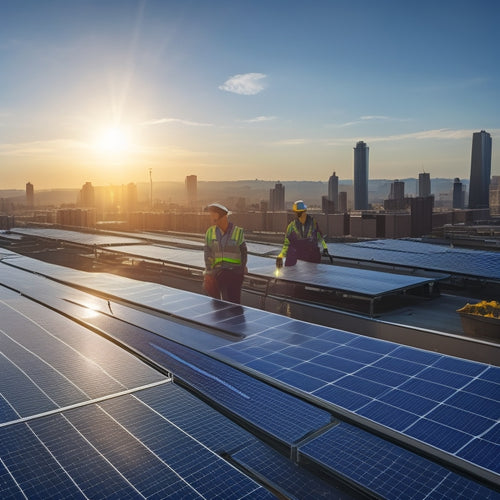
A 7-Step Guide to Solar Power System Installation
Share
You'll start by evaluating your energy needs, identifying areas for improvement and optimizing your energy efficiency to get the most out of your solar power system. Next, you'll choose the right equipment, including solar panels, inverters, and battery storage solutions. Then, you'll plan the system layout and design, considering factors like panel orientation and spacing. After preparing your roof and site, you'll install the solar panels, connect to the grid, and perform a final inspection and testing. By following these 7 steps, you'll be well on your way to utilizing the power of the sun and reducing your reliance on the grid - and that's just the beginning of your solar expedition.
Key Takeaways
- Assess daily energy consumption using past utility bills to determine the right solar panel system size for your needs.
- Choose the right equipment, including solar panel type, inverter option, and battery storage solution, to ensure optimal energy production.
- Plan the system layout and design, considering panel orientation, tilt, and row spacing, to maximize energy output and reduce shading.
- Ensure your roof and site are prepared by evaluating the roof condition, structural integrity, and electrical infrastructure to support the solar equipment.
- Install the solar panels securely, following safety standards and torque specifications, to ensure a safe and efficient system.
Assessing Your Energy Needs
Kick off your solar power system installation by sizing up your energy needs. You'll need to determine how much energy you consume daily to guarantee your solar power system meets your requirements. Review your past utility bills to calculate your average daily energy usage in kilowatt-hours (kWh). This will help you identify areas for improvement and optimize your energy efficiency.
Contemplate implementing energy efficiency tips, such as swapping incandescent bulbs with LEDs, upgrading to energy-efficient appliances, and optimizing your HVAC system. These changes can greatly reduce your energy consumption, allowing you to reap more solar energy benefits.
Next, assess your energy usage patterns. Identify the times of day when you consume the most energy and adjust your habits accordingly. You may need to think about installing a time-of-use (TOU) meter to track your energy usage patterns.
Choosing the Right Equipment
You've determined your energy needs, and now it's time to select the right equipment for your solar power system. Choosing the right solar panel types is vital, as they directly impact your system's efficiency.
Consider monocrystalline, polycrystalline, or thin-film panels, each with their pros and cons. Next, decide on inverter options, which convert DC power to AC for your home. String inverters, microinverters, and power optimizers are popular choices.
Battery storage is another important component, especially if you want to store excess energy generated during the day for nighttime use. Consider lead-acid, lithium-ion, or saltwater batteries, each with their own capacity and lifespan.
Monitoring systems allow you to track your energy production and consumption, guaranteeing your system is functioning at its best. You'll also need installation tools, such as wiring and connectors, to connect your equipment.
Don't forget to research financing options and local incentives, which can greatly reduce your upfront costs. Finally, consider maintenance tips to guarantee your system runs smoothly for years to come.
Planning System Layout and Design
With your equipment selected, it's time to plan the system layout and design. This vital step guarantees your solar power system operates at maximum efficiency.
You'll need to determine the best solar panel orientation to maximize energy production. In the northern hemisphere, a south-facing orientation is ideal, as it receives the most direct sunlight throughout the day. However, you may need to adjust this based on your roof's pitch, shading, and local building codes.
To enhance energy production, consider the following factors: panel tilt, row spacing, and wire management.
The tilt of your solar panels affects energy output, with a steeper tilt resulting in more energy generated during winter months. Row spacing is essential to prevent shading and secure adequate airflow. Proper wire management guarantees efficient energy transmission and reduces heat buildup.
Preparing Your Roof and Site
You'll need to assess your roof's condition to guarantee it can support the solar power system, checking for signs of wear, damage, or necessary repairs.
Next, evaluate your site according to key criteria, including shading, orientation, and local building codes.
Roof Condition Assessment
Before installing a solar power system, evaluating your roof's condition is vital to guarantee a safe and efficient installation. You need to evaluate your roof's material compatibility with the solar panels and confirm it can support the added weight. This involves inspecting the roof's age, condition, and material type. For instance, asphalt shingles may not be suitable for solar panels, while metal or tile roofs might be ideal.
Conduct a structural integrity evaluation to determine if your roof can bear the weight of the solar panels, mounting system, and other equipment. Check for signs of wear, cracks, or damage that could compromise the roof's structure. Verify that your roof's framing, decking, and rafters are sturdy enough to support the additional load.
It's essential to identify any potential issues early on to avoid costly repairs or even roof collapse. By evaluating your roof's condition, you can confirm a successful solar power system installation that meets your energy needs while maintaining the integrity of your roof.
Site Evaluation Criteria
After verifying your roof's structural integrity, it's time to assess your site's suitability for a solar power system.
You'll need to evaluate several key factors to guarantee a successful installation. First, review local zoning regulations and solar incentives to understand any restrictions or benefits associated with your project.
Next, consider the environmental impact of your system, including its visibility and potential effects on local wildlife.
Conduct a shading analysis to identify any obstacles that could reduce your system's energy output. This includes trees, buildings, and other structures that could cast shadows on your panels.
Your site's structural assessment should also include an evaluation of your electrical infrastructure, including your main service panel and electrical meter.
Don't forget to research local permitting requirements and obtain necessary permits before beginning your installation.
Finally, think about maintenance considerations, such as accessibility and cleaning requirements, to guarantee your system operates at peak efficiency.
Installing the Solar Panels
Your solar panel array's performance depends on proper installation, which is critical to achieving maximum energy output. You must guarantee that the solar panels are securely fastened to the mounting system, considering factors such as wind load, snow load, and roof orientation.
There are various solar panel types, including monocrystalline, polycrystalline, and thin-film, each with its own installation requirements.
You'll need specific installation tools, such as a torque wrench, socket set, and wire strippers, to complete the job efficiently.
Begin by laying out the solar panels on the roof, confirming they're spaced evenly and aligned with the mounting system. Next, secure the panels to the mounting system using the appropriate fasteners, such as clamps or bolts.
Make certain to tighten the fasteners to the recommended torque specification to prevent damage or electrical shock.
Connecting to the Grid
You've successfully installed your solar panel array, and now it's time to connect it to the grid. This vital step guarantees your system integrates seamlessly with the existing electrical infrastructure. Grid compatibility is fundamental, so it's important to confirm your system meets the utility company's interconnection requirements.
Begin by submitting an interconnection application to your utility company, providing detailed system specifications and installation plans. They'll review your application to verify your system's grid compatibility and schedule a site inspection.
During this inspection, the utility company will verify that your system meets their interconnection standards and identify any necessary upgrades or modifications.
Once approved, you'll receive permission to operate (PTO), allowing you to connect your system to the grid. The interconnection process typically takes several weeks to a few months, depending on the complexity of your installation and the utility company's workload.
Be prepared to address any issues or concerns raised during the inspection process, and don't hesitate to consult with your installation team if you need assistance.
Final Inspection and Testing
Three crucial stages remain before your solar power system is fully operational: final inspection, testing, and commissioning. You've made it this far, and now it's time to verify your system meets the required safety protocols and quality assurance standards.
Conduct a thorough visual inspection of the entire system, checking for any signs of damage, wear, or tear. Verify that all electrical connections are secure, and all components are properly installed and configured. Pay particular attention to the electrical panel, inverter, and mounting system.
Next, perform a series of tests to validate the system's performance. This includes measuring voltage, current, and power output to confirm they match the manufacturer's specifications.
You'll also need to test the system's grounding and bonding, as well as its ability to operate safely during various scenarios, such as grid outages or faults.
Frequently Asked Questions
Can I Install Solar Panels on a Metal or Tile Roof?
You can install solar panels on both metal and tile roofs, but you'll want to evaluate the metal roof advantages, such as durability and ease of installation, versus tile roof considerations, like added weight and potential waterproofing issues.
Do I Need to Trim Trees Near My Solar Panel Installation?
You're about to release a solar power behemoth, but don't let tree shading sabotage your plans; you'll need to trim nearby trees, ensuring a 10-foot branch clearance radius to enhance energy output, just like a surgeon precision-removes obstacles to reveal peak performance.
How Long Does a Typical Solar Panel Warranty Last?
You'll typically get a 25-year warranty on your solar panels, covering defects and performance guarantees, which aligns with the average solar panel lifespan, ensuring you're protected and powered for a quarter-century.
Can I Add More Panels to My System in the Future?
As you gaze into the sun-kissed horizon, you wonder if your solar system can evolve with your growing energy needs. Fortunately, you can add more panels in the future, ensuring seamless integration with your existing system, as long as you choose compatible panels for future expansion.
Will My Solar Panels Produce Energy During a Power Outage?
During a power outage, you won't generate energy with your solar panels unless you have energy storage and an inverter that can function independently of the grid, allowing you to capture and store power when the grid goes down.
Conclusion
As you flip the switch, the hum of your solar power system comes alive, like a sunrise bursting over the horizon. You've overcome the obstacles, and now your roof is a canvas of sleek, high-efficiency panels, capturing the sun's energy to power your home. With each kilowatt-hour, you're cutting ties with the grid and embracing a cleaner, greener future. Your 7-step expedition has paid off, and the sweet taste of energy independence is yours to savor.
Related Posts
-
Trends in Renewable Energy Storage Technologies
You're witnessing rapid advancements in renewable energy storage technologies aimed at improving efficiency and scala...
-

Solar Power for Reducing Carbon Footprint
Solar power is an effective strategy for reducing your carbon footprint. By adopting solar energy, you can cut greenh...
-

Solar Installation Guide for Commercial Properties
Implementing solar energy solutions in your commercial property can lead to significant long-term savings and sustain...

